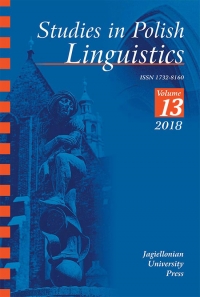The Prototypicality of Semantic Opposition in the Light of Linguistic Studies and Psycholinguistic Experiments
The Prototypicality of Semantic Opposition in the Light of Linguistic Studies and Psycholinguistic Experiments
Author(s): Nawoja Mikołajczak-MatyjaSubject(s): Semantics, Psycholinguistics
Published by: Wydawnictwo Uniwersytetu Jagiellońskiego
Keywords: semantics; corpus studies; psycholinguistics; semantic relations; prototype theory; semantic opposition;
Summary/Abstract: This paper aims to use the results of linguistic analyses, including corpus studies, and psycholinguistic experiments to present the relation of semantic opposition in terms of the prototype theory of concepts. A synthesis of linguists’ views on the factors defining the prototype of the category of semantic opposition is presented, and an attempt is made to determine the relationship between these factors. The need to distinguish prototypical and canonical examples of the relationship is also indicated. The results of the most important corpus studies concerning the relation of opposition are analysed in order to find ways of delineating the peripheral zones and the boundaries of the relation based on real contexts of use. The particular role of opposition pairs extracted from cohyponymic multi-element sets in forming the boundary areas of the category of opposition is highlighted. It is determined, on the basis of selected studies, which psycholinguistic techniques can provide evidence of the psychological reality of the prototypical nature of the category of semantic opposition, and which may serve as a basis for distinguishing the prototype of the category from the canon. In conclusion, some semantic, corporal, and psycholinguistic criteria are proposed for locating particular examples of the relation within the structure of the category of semantic opposition – that is, conditions for classifying examples as, accordingly: a) belonging to the strict centre of the category, b) lying near the centre, c) located in the peripheral part, or d) forming the fuzzy boundary of the category.
Journal: Studies in Polish Linguistics
- Issue Year: 13/2018
- Issue No: 1
- Page Range: 1-23
- Page Count: 23
- Language: English

